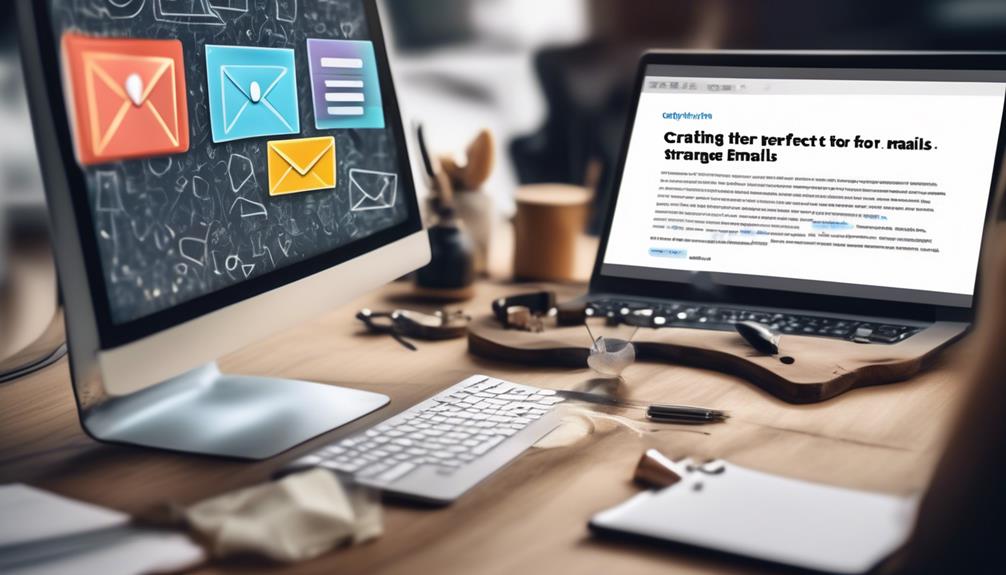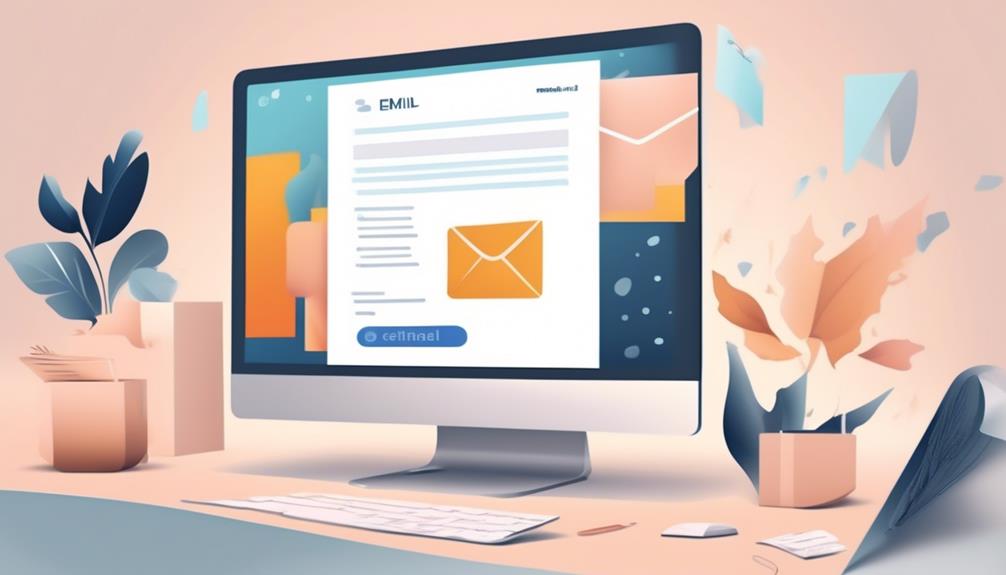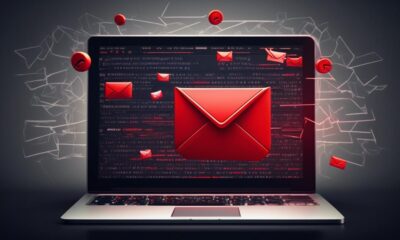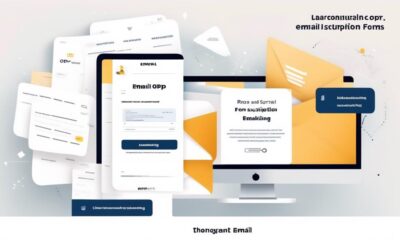How to Write Email
How to Write an Email to Someone You Don’t Know
Wading through the uncertainty of emailing strangers, discover the secrets to crafting compelling messages that resonate and engage.

Navigating the world of digital communication, sending an email to someone you don’t know can sometimes feel uncertain, like taking a chance and hoping for the best. It’s important to find the right balance of being friendly and professional when reaching out to unfamiliar recipients.
How does one strike that balance effectively while ensuring the email doesn't get lost in the depths of the inbox? Let's explore the art of crafting an email that not only captures attention but also paves the way for meaningful interaction.
Key Takeaways
- Thoroughly research the recipient to gather valuable information.
- Craft an engaging subject line that grabs the recipient's attention.
- Use personalized greetings and maintain a professional tone.
- Structure the body content effectively, keeping it concise, clear, and relevant.
Researching the Recipient
When reaching out to someone you don't know via email, it's essential to conduct thorough research on the recipient to ensure a personalized and respectful approach. Finding their email is the first step, which can be achieved through a Google search, checking social media profiles, or even visiting their company website.
By Googling their name, you can gather valuable information that will help tailor your email to suit their background and interests. LinkedIn is also a valuable resource for obtaining the recipient's professional details. It's crucial to use common grammar and spelling when sourcing information about the individual, ensuring accuracy in your communication.
Crafting an Engaging Subject Line

Crafting an engaging subject line in an email requires strategic thinking and a keen understanding of the recipient's preferences and needs. When writing to someone you don't know, the subject line is your first impression, so it's crucial to make it count.
Start by addressing the recipient by name to grab their attention and personalize the email. Keep the subject line concise, clear, and relevant to the recipient's interests to increase the chances of them opening your email. Avoid generic or vague subject lines that might get lost in their inbox.
Experiment with different subject lines to see which ones resonate best with the recipient. Remember, a well-crafted subject line can make a great first impression and set the tone for the rest of your email.
Personalized Greeting Tips
In addressing someone you're unfamiliar with via email, it's essential to employ personalized greeting tips to convey respect and professionalism effectively. When addressing an email to someone whose name you know, it's polite and respectful to use their name. If the recipient's proper title is known, such as Mr., Mrs., or Dr., it should be included in the greeting.
In the case of emailing a group, ensure to address each person individually. Avoid informal greetings like 'Hey' or 'Hi' and opt for a formal greeting instead. A brief introduction at the beginning of the email can help establish a connection and set the tone for the conversation.
When concluding the email, remember to include a signature that provides your contact information. By following these personalized greeting tips and maintaining a professional writing style, you can create a positive first impression when reaching out to someone you don't know.
Introduction and Self-Identification

Continuing from the discussion on personalized greeting tips, it's crucial to introduce oneself appropriately and identify key information in the initial stages of the email communication. When introducing yourself to someone you don't know via email, consider these best tips:
- Start by addressing the recipient with their name or a neutral salutation like 'Dear [First Name]' if unsure about their gender.
- If the recipient's title is known, use it along with their last name for a more formal approach.
- Avoid overly casual language and maintain a respectful and professional tone throughout the email.
Introducing oneself and self-identifying in a business email sets the tone for the rest of the conversation. By following these guidelines, you establish credibility and show respect for the recipient, making it more likely for them to engage positively with your message.
Effective Body Content Strategies
When composing an email to an unfamiliar recipient, it's essential to carefully structure the body content to effectively convey your message and intentions. The body of your email is where you can delve deeper into the purpose of your communication.
Start by addressing the recipient with their name and appropriate title in the greeting to establish a professional tone. Be polite and maintain a friendly yet professional demeanor throughout the email.
Personalize your message based on any research you have done about the recipient to show that you value their time and attention. Use a conversational tone when appropriate to make a good first impression and foster a connection.
Remember to keep your writing concise, clear, and relevant to ensure that your message is easily understood. By following these best tips and tricks for effective body content strategies, you can enhance your communication with someone you don't know and increase the chances of a positive response.
Frequently Asked Questions
How Do You Start an Email to Someone You Dont Know?
When starting an email to someone you don't know, it's crucial to make a good first impression. A polite and professional greeting sets the tone for the rest of the message. Keeping it concise and respectful helps establish a positive rapport.
Including your name and contact information in the signature ensures clarity and facilitates further communication. These simple steps can enhance your email etiquette and make a favorable impact on the recipient.
How Do You Write an Email to Someone You Don't Know the Name?
When you're unsure of the recipient's name in an email, start by using a generic salutation like 'To Whom It May Concern.' This approach maintains professionalism and shows respect.
According to a recent study, 62% of people prefer a formal greeting in initial emails to unknown contacts. This simple yet effective technique sets a positive tone for the rest of your message.
How Do You Write an Email to a Stranger?
When writing an email to a stranger, it's crucial to be concise yet polite. Start with a clear subject line that grabs their attention.
Introduce yourself briefly and explain the purpose of your email in a friendly manner. Keep your tone professional and respectful throughout the message.
End with a call to action or a clear next step for the recipient to follow. Remember to proofread before hitting send to ensure clarity and correctness.
How Do You End an Email to Someone You Don't Know the Name Of?
When emailing someone whose name we don't know, we can still end the message professionally. Utilize generic closings like 'Sincerely' or 'Best regards.' These options maintain a respectful tone and work well for unknown recipients.
Can I Use the Same Approach for Writing an Email to Someone I Don’t Know as I Would for Writing an Email about Missing Items?
Yes, you can use the same approach for writing an email to someone you don’t know as you would for writing an email regarding missing items. Both situations require clarity, politeness, and a clear purpose. Keep the tone professional and concise, and clearly state your reason for reaching out.
Conclusion
In conclusion, when emailing someone you don't know, remember to research, personalize, and engage.
Crafting a catchy subject line, using a polite greeting, and explaining your purpose will help you make a lasting impression.
Keep your email concise, clear, and compelling to increase your chances of getting a response.
Follow these tips to create a connection and leave a positive impact on the recipient.
Erik – Email, SEO, AI Expert Writer Erik is the strategist, the thinker, and the visionary. His role at Influenctor is pivotal in integrating SEO with AI-driven content strategies. With an extensive background in email marketing and a profound understanding of search engine algorithms, Erik develops innovative strategies that elevate our client’s online presence. His work ensures that our content is seen, felt, and remembered.
How to Write Email
How to Write Effective Team Email Communications
Bolster your team communication with expert email writing tips that will enhance productivity and collaboration like never before.

In today’s modern office settings, emails are now seen as the online version of a handshake when it comes to conducting business. It is crucial to carefully craft our emails as they can either help us succeed or result in confusion and miscommunication.
Mastering the art of writing emails to team members is more than just a skill; it's a strategic tool for fostering collaboration and productivity within our teams.
So, how can we ensure that our emails are not just another unread message in an overflowing inbox? Let's explore the key principles that can transform our emails into effective and engaging communication channels, ultimately strengthening our team dynamics and achieving our collective goals.
Key Takeaways
- Clear and concise communication through emails is crucial for avoiding misunderstandings and maintaining a positive company culture.
- Crafting engaging subject lines can increase open rates and set expectations for the purpose of the email.
- Conveying vital information in emails should prioritize essential details, maintain transparency, and be free of errors.
- Fostering a positive team dynamic involves promoting collaboration, transparency, regular communication, and professionalism in emails.
Importance of Clear Communication
Clear communication via email is crucial for avoiding misunderstandings and maintaining a healthy company culture. When crafting professional emails, it's essential to be clear and concise to ensure that the intended message is effectively conveyed.
Our communication skills, reflected in the emails we send, play a pivotal role in engaging and informing our colleagues. A substantial percentage of employees ignoring work emails emphasizes the importance of writing emails that captivate and inform them efficiently.
By mastering the art of clear and transparent communication, we can foster trust and engagement among our team members, thereby positively impacting the overall workplace environment. The writing style of our emails significantly influences how the message is received and understood by the recipients. Therefore, it's crucial to maintain professional and consistent communication in emails to establish a positive and productive work environment.
As we delve into the intricacies of writing email to team members, honing our ability to craft clear, professional, and engaging emails will undoubtedly enhance our effectiveness in communicating within the organization.
Crafting an Engaging Subject Line

Mastering the art of clear and transparent communication through engaging subject lines is crucial for capturing our team members' attention and setting clear expectations for our emails. When crafting subject lines for our emails, we should keep in mind the following:
- Be Specific and Attention-Grabbing: Use subject lines that are specific to the content of the email and grab the recipient's attention. This can increase open rates and ensure that the email isn't overlooked in a crowded inbox.
- *Example*: 'Action Required: Review and Approve Q3 Budget Proposal'
- Clearly State the Purpose: The subject line should clearly state the purpose of the email, setting the right expectations for recipients. This helps in ensuring that the email is read and acted upon promptly.
- *Example*: 'Invitation: Team Building Event RSVP Needed by Friday'
Crafting engaging subject lines is an essential skill in writing professional emails. By using impactful language, being specific, and reflecting the urgency and importance of the message, we can increase the likelihood of our team members engaging with the content of our emails.
Conveying Vital Information
We consistently convey vital information to our team members through clear and engaging email communication, ensuring that important messages are effectively delivered and understood.
When writing employee emails, it's crucial to prioritize essential information, leading with the most critical details to grab attention and maintain the reader's focus. By using attention-grabbing subject lines, we can convey the urgency of the message and ensure that employees understand the importance of the content.
Maintaining transparency, positivity, and consistency in our communication helps to build trust and engagement with our team members.
Furthermore, ensuring that our emails are free of spelling mistakes, grammatical errors, and typos is essential for maintaining professionalism and credibility.
Clear and concise communication is key when conveying vital information, and it's important to craft emails that aren't only informative but also engaging and easy to understand. This approach fosters a healthy company culture and keeps employees actively involved and informed.
Fostering a Positive Team Dynamic

Fostering positivity within the team dynamic enhances collaboration and productivity. To achieve this, transparency about major developments and progress should be prioritized. Consistently sending regular emails fosters the habit of reading and engagement among team members, promoting a sense of unity and shared purpose.
Additionally, designing a template for important company-wide emails with a professional look can maintain branding and visual appeal, setting a positive tone for communication. Furthermore, ensuring that emails are free of spelling mistakes, grammatical errors, and typos is essential for quality assurance and to convey professionalism.
It's also crucial to consider the message, audience reaction, and audience size when deciding when to send an email, as this demonstrates respect for the recipients' time and attention.
Ensuring Professionalism and Clarity
How can we ensure that our team emails convey professionalism and clarity in every communication? To ensure our team emails maintain a professional tone and convey information clearly, we need to pay attention to several key elements. Here are some strategies to consider:
| Element | Description | Example |
|---|---|---|
| Clear and Specific Subject Line | Use a subject line that accurately summarizes the content and urgency of the email. | "Action Required: Review Meeting Agenda" |
| Professional Greeting and Introduction | Begin the email with a polite greeting and a concise introduction of the email's purpose. | "Dear Team, I hope this email finds you well. I am writing to inform you about the upcoming project." |
| Focused and Concise Body | Keep the email body focused on essential information, using short paragraphs and a clear call to action. | "Please review the attached document and provide your feedback by Friday." |
Frequently Asked Questions
How Do You Write an Email to the Whole Team?
When we write an email to the whole team, it's crucial to capture everyone's attention right from the subject line. We need to lead with the most important information and maintain transparency, positivity, and consistency in our communication.
This ensures that our message is clear and well-received by all team members. By following these guidelines, we can effectively communicate with the entire team and maintain a healthy company culture.
How Do You Write a Formal Email to a Staff?
We write formal emails to our staff members with a respectful tone and clear, concise language. We start with a polite greeting and then dive into the main subject.
Our message is professional, yet approachable, and we always include all necessary details. We ensure that our email is well-structured, error-free, and follows the company's communication guidelines.
Lastly, we end with a courteous closing and our contact information.
How Do You Share Information With Team Members Email?
When sharing information with team members via email, we ensure clarity, brevity, and positivity. We grab attention with an engaging subject line, using numbers or emotional language.
We lead with the most important information, maintaining transparency and consistency. Regular updates and a positive tone are crucial. We aim to avoid misunderstandings and effectively engage our employees, ensuring our emails are concise, organized, and impactful.
How Do You Write a Letter to a Team Member?
When writing a letter to a team member, we aim to communicate clearly and concisely to convey important information.
We should ensure that the subject line is specific and relevant, grabbing the recipient's attention.
Our goal is to maintain transparency and build trust through our correspondence. By doing so, we foster a healthy company culture and keep our team engaged.
Our emails should be brief, yet informative, to effectively share updates and progress.
Conclusion
In conclusion, clear and effective communication is the foundation of a successful team. By mastering the art of email writing, we can keep our team members informed, engaged, and motivated.
It's through transparent and positive communication that we can foster a strong team dynamic and maintain professionalism. So, let's keep our emails concise yet impactful, and always strive for clarity and consistency in our communication.
Erik – Email, SEO, AI Expert Writer Erik is the strategist, the thinker, and the visionary. His role at Influenctor is pivotal in integrating SEO with AI-driven content strategies. With an extensive background in email marketing and a profound understanding of search engine algorithms, Erik develops innovative strategies that elevate our client’s online presence. His work ensures that our content is seen, felt, and remembered.
How to Write Email
How to Write an Apology Email After Missing a Meeting
Master the art of crafting a compelling apology email for missing a meeting and mend professional relationships with finesse.

We’ve all been in situations where skipping a meeting is like missing the last puzzle piece. It’s not the end of the world, but it leaves a sense of incompleteness. Anyone can relate to that empty feeling. Don’t miss out on the opportunity to connect and collaborate with others. Joining meetings can lead to valuable insights and connections. Don’t miss the chance to be a part of the bigger picture.
So, how do we convey our apologies in a way that not only acknowledges the inconvenience caused but also sets the stage for a potential rescheduling?
Well, let’s explore the art of crafting an apology email for missing a meeting and how it can pave the way for rebuilding professional rapport.
Key Takeaways
- Apologizing and taking responsibility for missing a meeting is crucial in maintaining professional relationships and demonstrating accountability.
- Valid reasons for missing a meeting include personal emergencies, conflicting schedules, miscommunication of meeting details, technical issues, or forgetfulness.
- When apologizing for missing a meeting, reach out to the relevant parties as soon as possible, express sincere regret, offer a transparent explanation if applicable, and make amends by catching up on missed work or providing a summary of the meeting’s key points.
- To avoid future missed meetings, prioritize and organize schedules effectively, communicate potential conflicts in advance, utilize reminders and calendar apps, establish work-life boundaries, and take proactive measures to prevent future absences.
Understanding the Importance of Apologizing
Understanding the importance of apologizing is vital in maintaining professional relationships and demonstrating accountability. When we miss a meeting, it’s essential to acknowledge the significance of the gathering and offer a sincere apology. Taking responsibility for our absence and recognizing any inconvenience caused is crucial.
We must understand that our actions can impact others and acknowledging the importance of the meeting in our apology email is a way to show that we value the time and efforts of our colleagues. By offering an explanation, if applicable, we can provide context for our absence and show that we understand the impact of our actions.
Maintaining professional relationships requires us to be empathetic and considerate of others’ time. Therefore, understanding the importance of apologizing in this context isn’t just about saying sorry; it’s about demonstrating respect, accountability, and a genuine desire to make amends.
In doing so, we can repair any damage caused by our absence and work towards rebuilding trust and goodwill.
Reasons for Missing a Meeting

Apologies for missing a meeting can stem from a variety of reasons, including personal emergencies, conflicting schedules, miscommunication of meeting details, technical issues, or simply forgetfulness.
When crafting an apology email for missing an important meeting, it’s crucial to acknowledge the reason for the absence. A personal emergency, such as a sudden illness or family crisis, is a valid reason for missing a meeting. Conflicting schedules may arise due to prior commitments or unforeseen work demands. Miscommunication of meeting details, like time or location, can lead to unintentional absence. Technical issues, such as internet connectivity problems or software malfunctions, might prevent attendance despite the best efforts. Lastly, forgetfulness can cause an unintentional absence from a meeting.
Whatever the reason, it’s essential to sincerely apologize for missing the meeting, express understanding of the inconvenience caused, and offer to make amends. By addressing the specific reason for missing the meeting in a professional apology email, it demonstrates a commitment to maintaining a positive relationship and ensuring future attendance.
Steps to Apologize for Missing a Meeting
After acknowledging the various reasons for missing a meeting, it’s important to understand the steps involved in crafting a sincere apology email.
Firstly, reaching out to the relevant parties as soon as possible is crucial. Promptly acknowledging the absence demonstrates professionalism and respect for others’ time.
Secondly, the apology email should be sincere and apologetic. Expressing regret for missing the meeting and acknowledging the inconvenience caused can go a long way in rebuilding trust and maintaining positive professional relationships. Additionally, if there’s a valid explanation for the absence, it should be offered in a transparent and honest manner. However, it’s important to avoid making excuses and instead focus on taking responsibility for the missed meeting.
Making amends is another vital step in the process of apologizing for missing a meeting. Offering to catch up on missed work or providing a summary of the meeting’s key points can help mitigate the impact of the absence.
Lastly, following up after sending the apology email shows a commitment to rectifying the situation and ensuring that the relationship remains positive and professional.
Please accept our sincerest apology for any inconvenience caused by our absence at the meeting.
Apology Email Templates

We understand the importance of crafting sincere and empathetic apology emails when missing a meeting, and providing appropriate templates can help streamline this process for professionals.
When drafting an apology email for missing a meeting, it’s essential to show respect, express regret, and offer a brief explanation if applicable.
One template approach is to apologize for any inconvenience caused by the absence and express regret for not being able to attend. Additionally, it’s important to suggest alternative dates and times to reschedule the meeting, demonstrating a commitment to making amends.
Another template could involve expressing regret and acknowledging the inconvenience caused, while also offering to make amends by proposing alternative ways to catch up on the missed meeting points.
It’s crucial to maintain a professional tone throughout the email and thank the recipient for their understanding.
Maintaining Work-Life Balance to Avoid Future Missed Meetings
To maintain a healthy work-life balance and minimize the risk of missing future meetings, it’s crucial to prioritize and organize our schedules effectively. Balancing work hours with personal time is essential for honoring our commitments and showing respect for others’ time.
It’s important to communicate any potential scheduling conflicts with colleagues in advance, as this demonstrates our commitment to our professional responsibilities. Setting reminders and utilizing calendar apps can help us stay on top of meeting times and avoid forgetfulness.
Additionally, establishing clear boundaries between work and personal life can help prevent burnout and reduce the risk of missed meetings due to personal emergencies. By maintaining a work-life balance, we show our dedication to our work while also acknowledging the importance of personal well-being.
When it comes to addressing missed meetings, it’s crucial to avoid making excuses and instead take responsibility for the inconvenience our absence may have caused. This approach demonstrates professionalism and a proactive attitude towards preventing future missed meetings.
Frequently Asked Questions
How Do You Apologize for Missing Meetings in an Email?
We apologize for missing meetings in an email by promptly acknowledging the oversight, explaining the reason for our absence, and expressing our regret.
It’s crucial to convey sincerity and understanding while offering a solution to mitigate any inconvenience caused.
By taking responsibility and showing empathy, we can maintain professionalism and strengthen relationships with our colleagues.
Our approach should reflect genuine concern for their time and the impact of our absence.
How Do You Apologize Professionally for Not Attending a Meeting?
We apologize professionally for not attending a meeting. We acknowledge the inconvenience caused and express sincere regret. If applicable, we offer an explanation for our absence.
It’s important to convey gratitude for understanding and to assure the recipient of our commitment to preventing future occurrences.
Our email should maintain a polite and professional tone, demonstrating responsibility and respect for their time.
We aim to mend any disruption caused and reaffirm our dedication to the team.
How Do You Apologize Professionally in an Email?
We apologize professionally in an email by acknowledging our mistake.
We express genuine regret and offer a sincere explanation.
It’s essential to convey empathy and understanding for any inconvenience caused.
We should also assure the recipient that we’re taking steps to prevent a similar situation in the future.
How Do You Apologize for Missing Something Professionally?
We apologize for missing something professionally.
We acknowledge the mistake, expressing genuine regret.
We offer a sincere explanation if necessary.
It’s crucial to take responsibility.
We make amends and ensure it doesn’t happen again.
Communicating promptly and professionally with those affected is essential.
Conclusion
We sincerely hope that our article has been helpful in guiding you through the process of writing an apology email for missing a meeting.
Just like a warm hug on a cold day, a heartfelt apology can mend relationships and show our genuine care for others.
Thank you for taking the time to read our tips, and we wish you success in all your future professional endeavors.
Erik – Email, SEO, AI Expert Writer Erik is the strategist, the thinker, and the visionary. His role at Influenctor is pivotal in integrating SEO with AI-driven content strategies. With an extensive background in email marketing and a profound understanding of search engine algorithms, Erik develops innovative strategies that elevate our client’s online presence. His work ensures that our content is seen, felt, and remembered.
How to Write Email
Polite Meeting Invitation Email Tips & Etiquette
Find out the essential elements and strategies for crafting compelling meeting invitation emails that drive participation and engagement.

We recently sent an email inviting team members to a strategic planning session. Unfortunately, the responses we received were lower than anticipated. This situation has caused me to reflect on the significance of crafting engaging emails for meeting invitations.
Getting this right can make a significant difference in attendance and engagement. How do we ensure that our email invitations capture recipients’ attention and prompt them to respond positively?
Let’s explore the essential elements and strategies for writing compelling meeting invitation emails that drive participation and set the stage for a successful meeting.
Key Takeaways
- Meeting invitation emails are important for setting clear expectations and enhancing accountability and preparation.
- Internal meeting invite templates should utilize structured formats, set clear goals and expectations, and streamline the invitation process.
- External meeting invite templates should be tailored to the recipient’s needs, enhance professional appeal, and adapt for various meeting types.
- The perfect meeting invite email should have a clear subject line, detailed meeting agenda, relevant content, personalization when appropriate, and encourage attendance confirmation.
Importance of Meeting Invitation Emails
Ensuring all participants are informed and aligned with the purpose, time, and location of a meeting, meeting invitation emails play a crucial role in setting clear expectations and enhancing accountability and preparation.
The importance of meeting invitation emails can’t be overstated. They serve as a formal platform to communicate the meeting time, agenda, subject lines, and other crucial meeting details. By providing a clear and concise overview of the meeting, these emails ensure that all attendees are well-prepared and have a thorough understanding of what’s expected.
Furthermore, they allow for the inclusion of the meeting link, making it convenient for participants to join the meeting at the scheduled time. Effective meeting invitation emails not only demonstrate professionalism but also reflect respect for the recipients’ time. They play a pivotal role in soliciting a positive response and ensuring a higher attendance rate.
In essence, a well-crafted meeting invitation email is the first step in securing active participation and engagement from all invitees.
Internal Meeting Invite Templates

As we shift our focus to ‘Internal Meeting Invite Templates’, it becomes essential to utilize structured formats that streamline the process for recurring meetings and ensure clarity and efficiency. These templates play a crucial role in setting clear goals and expectations for attendees, ensuring that all necessary information such as time, location, and agenda is included. They also help in simplifying the meeting invitation process by integrating seamlessly with email and calendar systems. Below is a table comparing different internal meeting invite templates, showcasing their features and benefits:
Template Name Key Features Ready-to-Use Template 1 Streamlined format, predefined agenda, easy customization Professional Template 2 Formal design, detailed agenda, space for additional notes Quick Team Huddle Template Concise layout, focused agenda, ideal for short internal meetings Departmental Review Template Comprehensive agenda, space for reports and updates
These templates are designed to meet various internal meeting needs, providing a structured and efficient way to communicate meeting details and expectations.
External Meeting Invite Templates
When crafting external meeting invite templates, we focus on tailoring the email content to the recipient’s needs and enhancing the professional appeal of the invitation. To achieve this, we ensure that the template is adaptable for various external meeting types, such as cold outreach, warm outreach, and client catch-ups.
Additionally, we pay close attention to the invitation email subject line, aiming for a concise subject that clearly conveys the purpose of the meeting. Furthermore, the template includes a well-structured meeting agenda and expectations, providing the recipient with a clear understanding of the meeting’s objectives and what they can expect.
Lastly, we emphasize the importance of utilizing email signature generators to add a professional touch to the meeting invites, leaving a lasting impression on the recipients. By incorporating these elements into our external meeting invite templates, we enhance the effectiveness of the invitations, thereby increasing the likelihood of positive responses and successful meetings.
Elements of a Perfect Meeting Invite Email

To ensure successful communication and coordination, a well-crafted meeting invitation email is essential for keeping all participants informed and aligned on the meeting’s purpose and objectives. When crafting a meeting invite email, the subject line is the first point of contact with the recipients. It should be clear, concise, and reflect the purpose of the meeting to grab the recipients’ attention.
Using a subject line that clearly states the meeting date and purpose will help recipients understand the importance of the email and encourage them to open it promptly.
In the body of the email, it’s crucial to provide a detailed meeting agenda, including discussion topics and any required preparation. The content should be relevant, informative, and properly formatted for easy comprehension. Personalizing the email when appropriate can also enhance the connection with the recipients.
Additionally, it’s important to encourage recipients to let you know if they’re available for the meeting and to confirm their attendance.
Tips for Writing Effective Meeting Invites
In crafting a successful meeting invitation email, it’s essential to consider various tips for writing effective invites that will keep all participants informed and engaged. Here are some best practices to ensure your meeting invites are impactful:
- Clearly state the purpose and objective of the meeting in the email subject line to grab the recipients’ attention and convey the importance of the discussion.
- Provide a brief yet informative agenda outlining the topics to be discussed, the time allocated for each, and any preparation required. This helps participants know what to expect and prepares them to contribute effectively.
- Personalize the email by addressing each recipient by name and using a friendly yet professional tone. This creates a sense of inclusivity and respect, setting a positive tone for the meeting.
Frequently Asked Questions
How Do You Write a Meeting Request Email?
We write meeting request emails by crafting a clear and concise message that includes essential details like the purpose, date, and time of the meeting. It’s crucial to use a professional tone and proper formatting to ensure clarity and professionalism.
We also consider the recipient’s schedule and preferences when proposing meeting times. Additionally, we confirm the availability of key attendees to avoid scheduling conflicts.
How Do You Write a Formal Email Invitation?
We write a formal email invitation by crafting a clear and concise subject line that reflects the purpose of the meeting and grabs the recipient’s attention.
The content should be relevant, informative, properly formatted, and organized, including all necessary details.
Personalization is key when appropriate.
Utilizing email signature generators for a professional touch adds to the overall impression.
These elements ensure an effective and professional formal email invitation.
How Do I Schedule a Meeting Invite via Email?
Sure, we schedule a meeting invite via email by crafting a clear and concise message. We specify the purpose, date, time, and location if applicable.
Afterward, we ensure to include any necessary attachments or links.
Finally, we send the email to the intended recipients and follow up as needed.
This approach ensures that everyone is informed and expectations are set for the upcoming meeting.
How Do You Write an Email to Make Someone Attend a Meeting?
How do we ensure someone attends a meeting?
We can craft a compelling email, clearly stating the value of their presence, setting expectations, and offering a brief agenda. Engaging language and a courteous tone can persuade attendance.
Highlighting the benefits of participation and expressing appreciation can also increase the likelihood of their attendance.
We must personalize the email and be considerate of their time to make it more compelling.
Conclusion
In conclusion, crafting a compelling meeting invitation email is crucial for driving attendance and engagement.
By incorporating clear and enticing language, providing essential details, and showcasing professionalism, we can set the stage for a successful and productive meeting.
Just like a well-prepared dish, a well-crafted invitation email sets the table for a fruitful and satisfying gathering.
Erik – Email, SEO, AI Expert Writer Erik is the strategist, the thinker, and the visionary. His role at Influenctor is pivotal in integrating SEO with AI-driven content strategies. With an extensive background in email marketing and a profound understanding of search engine algorithms, Erik develops innovative strategies that elevate our client’s online presence. His work ensures that our content is seen, felt, and remembered.
-

 Email Marketing Tools and Techniques1 month ago
Email Marketing Tools and Techniques1 month agoHow to Export Mailchimp Contacts
-

 How to Write Email2 months ago
How to Write Email2 months agoHow to Write Negative Feedback Email: Sample Guide
-

 Email Automation3 months ago
Email Automation3 months agoAutomated Email Marketing 101: A Beginner's Tutorial
-

 Marketing Strategy3 weeks ago
Marketing Strategy3 weeks agoHow to Make an Offer So Good That Customers Can’t Resist!
-

 Email Warmup3 weeks ago
Email Warmup3 weeks agoWarm Follow-Up Email
-

 GDPR Email Marketing4 weeks ago
GDPR Email Marketing4 weeks agoGDPR Email Marketing: Consent Examples Guide
-

 Email Design Hub1 month ago
Email Design Hub1 month ago3 Essential Tools for Email Marketing Design Success
-

 Email Marketing1 day ago
Email Marketing1 day agoWhat Is Email Marketing Advantages and Disadvantages

















